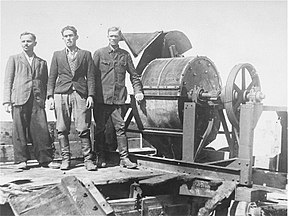
Back تاريخ زائف Arabic Фалшифициране на историята Bulgarian Nagennouriezh Breton Pseudohistòria Catalan Pseudohistorie Czech Geschichtsfälschung German Prihistoria falsado Esperanto Pseudohistoria Spanish Pseudoajalugu Estonian Sasihistoria Basque
Pseudohistory is a form of pseudoscholarship that attempts to distort or misrepresent the historical record, often by employing methods resembling those used in scholarly historical research. The related term cryptohistory is applied to pseudohistory derived from the superstitions intrinsic to occultism. Pseudohistory is related to pseudoscience and pseudoarchaeology, and usage of the terms may occasionally overlap. Although pseudohistory comes in many forms, scholars have identified many features that tend to be common in pseudohistorical works; one example is that the use of pseudohistory is almost always motivated by a contemporary political, religious, or personal agenda. Pseudohistory also frequently presents sensational claims or a big lie about historical facts which would require unwarranted revision of the historical record.[3]
Another hallmark of pseudohistory is an underlying premise that scholars have a furtive agenda to suppress the promotor's thesis—a premise commonly corroborated by elaborate conspiracy theories. Works of pseudohistory often point exclusively to unreliable sources—including myths and legends, often treated as literal historical truth—to support the thesis being promoted while ignoring valid sources that contradict it. Sometimes a work of pseudohistory will adopt a position of historical relativism, insisting that there is really no such thing as historical truth and that any hypothesis is just as good as any other. Many works of pseudohistory conflate mere possibility with actuality, assuming that if something could have happened, then it did.
Notable examples of pseudohistory include British Israelism, the Lost Cause of the Confederacy, the Irish slaves myth, the witch-cult, Armenian genocide denial, Holocaust denial, the clean Wehrmacht myth, the 16th- and 17th-century Spanish Black Legend, and the claim that the Katyn massacre was not committed by the Soviet NKVD.
- ^ Herf, Jeffrey (2006). The Jewish Enemy: Nazi Propaganda during the World War II and the Holocaust. Harvard University Press. p. 127. ISBN 978-0-674038-59-2.
- ^
- Marchand, Laure; Perrier, Guillaume (2015). Turkey and the Armenian Ghost: On the Trail of the Genocide. McGill-Queen's Press. pp. 111–112. ISBN 978-0-7735-9720-4.
The Iğdır genocide monument is the ultimate caricature of the Turkish government's policy of denying the 1915 genocide by rewriting history and transforming victims into guilty parties.
- Hovannisian 2001, p. 803. "... the unbending attitude of the Ankara government, in 1995 of a multi-volume work of the prime ministry's state archives titled Armenian Atrocities in the Caucasus and Anatolia According to Archival Documents. The purpose of the publication is not only to reiterate all previous denials but also to demonstrate that it was in fact the Turkish people who were the victims of a genocide perpetrated by the Armenians."
- Cheterian 2015, pp. 65–66. "Some of the proponents of this official narrative have even gone so far as to claim that the Armenians were the real aggressors, and that Muslim losses were greater than those of the Armenians."
- Gürpınar 2016, p. 234. "Maintaining that 'the best defence is a good offence', the new strategy involved accusing Armenians in response for perpetrating genocide against the Turks. The violence committed by the Armenian committees under the Russian occupation of Eastern Anatolia and massacring of tens of thousands of Muslims (Turks and Kurds) in revenge killings in 1916–17 was extravagantly displayed, magnified and decontextualized."
- Marchand, Laure; Perrier, Guillaume (2015). Turkey and the Armenian Ghost: On the Trail of the Genocide. McGill-Queen's Press. pp. 111–112. ISBN 978-0-7735-9720-4.
- ^ "Joseph Goebbels On the "Big Lie"". www.jewishvirtuallibrary.org. Retrieved 2024-03-27.
© MMXXIII Rich X Search. We shall prevail. All rights reserved. Rich X Search


